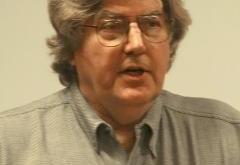Professor Butler D. Shaffer teaches at Southwestern University School of Law, LA, California. For the past two years he has been presenting his students with a much-needed voting exercise, one that ought to be performed in every campus across our nations.
These days, students do their share to undermine intellectual and other freedoms. Students—especially those on the Left, who are the cloned majority—like to think of themselves as gritty revolutionaries. With their fealty to politically correct repressive speech codes, and campus-based, Kenneth Starr-like inquisitions, our youngsters promote rather than quell institutionalized violence.
On the first day of class, and without any introductory ado, Prof. Shaffer proceeds to hand each of his students the following ballot. It reads: “It’s time to elect the leader of a great nation, and you have been presented with the following candidates:
CANDIDATE “A”: A well known critic of government, this man has been involved in tax protest movements, and has openly advocated secession, armed rebellion against the existing national government, and even the overthrow of that government. He is a known member of a militia group that was involved in a shootout with law enforcement authorities. He opposes the gun control efforts of the present government as well as the restrictions it imposes on open immigration into this country. He is a businessman who has earned his fortune from such businesses as alcohol, tobacco, retailing and smuggling.
CANDIDATE “B”: A decorated army war veteran, this man is an avowed nonsmoker and dedicated public health advocate. His public health interests include the fostering of medical research and his dedication to eliminating cancer. He opposes the use of animals in conducting such research. He has supported restrictions on the use of asbestos, pesticides, and radiation, and favours government determined occupational health and safety standards, as well as the promotion of such foods as wholegrain bread and soybeans. He is an advocate of government gun-control measures. An ardent opponent of tobacco, he has supported increased restrictions on both the use of and advertising of tobacco products. Such advertising restrictions include: [1] not allowing tobacco use to be portrayed as harmless or a sign of masculinity; [2] not allowing such advertising to be directed at women; [3] not drawing attention to the low nicotine content of tobacco products; and [4] limitations as to where such advertisements may be made. This man is a champion of environmental and conservationist programs, and believes in the importance of sending troops into foreign countries in order to maintain order therein.
After introducing the candidates, Prof. Shaffer asks the students to select the candidate for whom they would vote. For two years in a row, members of four classes gave Candidate “A” 47 votes. Candidate “B” got a whopping 141 votes. Put proportionally: Candidate “B” received 75 percent of the student vote, while candidate “A” got 25 percent of their ballots.
After collecting the ballots, our professor informs the students that Candidate “A” is a composite of the American Founding Fathers, among whom were Thomas Jefferson, George Washington, Sam Adams, John Hancock, and Patrick Henry.
Candidate “B” is Adolph Hitler.
There is an interesting postscript to one of these classes.
While delivering a lecture in constitutional law, Prof. Shaffer was expounding on the Schechter case, where the Supreme Court struck down the New Deal’s National Industrial Recovery Act.
The New Deal was President Franklin D. Roosevelt’s plan to replace traditional American laissez faire with a government-regulated economy, inspired to a large degree by the socialist countries of Soviet Russia and Nazi Germany (yes, both were principally socialist. But, as Ludwig von Mises pointed out, Hitler demoted his entrepreneurs, while Stalin liquidated them).
Roosevelt had unconstitutionally arrogated to himself the unfettered right to enact laws for governing trade and industry throughout the country. Like his contemporaries in governmental anti-trust departments, Roosevelt deployed codes for “fair competition” in order to seize the property of citizens, often bankrupting them.
Prof. Shaffer also informs the students how popular state collectivism was throughout the world: Stalin, Hitler, Mussolini, Franco and Roosevelt being the better-known examples, and how—hush, hush—Hitler and Mussolini had been revered by renowned people the world over, including Gandhi and Churchill.
At this point, one of the students pipes up: “I don’t see how you can say that,” he intones. “How could a man like Adolph Hitler have been popular with so many people?”
“You tell me,” Prof. Shaffer responded, leaning over the podium for impact. “Just two weeks ago 75 percent of you in this class voted for him.”
The lecture hall grows dead silent as the professor pauses to let the point sink in.
©2000 By Ilana Mercer
The Calgary Herald
November 23
CATEGORIES: Elections, Fascism, Founding Fathers, Left-liberalism, New Deal, Political Philosophy, Political Theory

 print
print